CES isn’t just about the latest consumer gadgets. There’s something for engineers, too.
From what I’ve heard, the exhibit halls of the Consumer Electronics Show (CES) is quite a circus. Having never attended the live event, I can’t confirm that from personal experience. This year, CES went virtual so how could I not “attend?”
While the show featured TVs, robots, phones, and other consumer devices, CES was not without products for engineers. Much of the virtual exhibits for engineers centered around Wi-FI6 and Wi-Fi6E. That included radios, RF front ends, antennas, IP, and modules.
Why do semiconductor companies exhibit at CES? Several exhibitors told me that it’s to meet with customers and see what their customers are doing with their products. So many consumer devices include Wi-Fi, which brings numerous companies that provide radios, RF front ends, amplifiers, and antennas. Others, not mentioned here, didn’t exhibit wireless semiconductor products but many provide devices for power management. Companies with wireless components at CES appear below, in alphabetical order. Click on the images to enlarge them
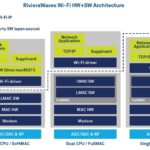 CEVA‘s 5G and Wi-Fi IP included the company’s RivieraWaves Wi-Fi IP family, a suite of IPs and platforms that let engineers embed Wi-Fi connectivity into SoCs and ASSPs. RivieraWaves adds PHY modem and MAC functions, including Lower MAC (LMAC) and Full MAC software protocol stacks. It can be configured with either a hardwired modem for low power consumption or a software-defined modem (SDM) for flexibility. The SDM is implemented executed on a CEVA DSP core.
CEVA‘s 5G and Wi-Fi IP included the company’s RivieraWaves Wi-Fi IP family, a suite of IPs and platforms that let engineers embed Wi-Fi connectivity into SoCs and ASSPs. RivieraWaves adds PHY modem and MAC functions, including Lower MAC (LMAC) and Full MAC software protocol stacks. It can be configured with either a hardwired modem for low power consumption or a software-defined modem (SDM) for flexibility. The SDM is implemented executed on a CEVA DSP core.
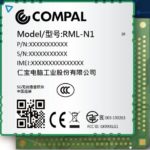 Compal was one of several companies exhibiting 5G/LTE modules that let engineers add 5G to IoT devices and customer premises equipment (CPE) such as routers and access points. As with other modules covered here, connections to the host come through PCIe links but may also use USB, SIM, I2C, SPI, or I2S interfaces. Modules are available in M.2 or land grid array (LGA) form factors (LGA shown, M.2 form factors show below).
Compal was one of several companies exhibiting 5G/LTE modules that let engineers add 5G to IoT devices and customer premises equipment (CPE) such as routers and access points. As with other modules covered here, connections to the host come through PCIe links but may also use USB, SIM, I2C, SPI, or I2S interfaces. Modules are available in M.2 or land grid array (LGA) form factors (LGA shown, M.2 form factors show below).
 Fibocom was another company exhibiting M.2 and LGA 5G modules at CES (LGA shown). Using a Qualcomm X55 5G modem and Arm Cortex-A7 processor, Fibocom’s modules support 5G standalone and non-standalone networks through its four antennas. Different models are available depending on country and region of use.
Fibocom was another company exhibiting M.2 and LGA 5G modules at CES (LGA shown). Using a Qualcomm X55 5G modem and Arm Cortex-A7 processor, Fibocom’s modules support 5G standalone and non-standalone networks through its four antennas. Different models are available depending on country and region of use.
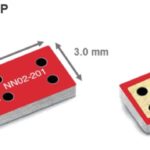 Fractus Antennas manufactures 5G and Wi-Fi antennas that you can embed in mobile and stationary IoT devices and CPE. The company touts its ONE xTEND chip antenna (shown) as the world’s smallest IoT antenna. Larger models such as the DUO xTEND and TRIO xTEND provide longer reach. The TRIO xTEND is included in an evaluation board from Sequans. See Sequans below for more on the evaluation board.
Fractus Antennas manufactures 5G and Wi-Fi antennas that you can embed in mobile and stationary IoT devices and CPE. The company touts its ONE xTEND chip antenna (shown) as the world’s smallest IoT antenna. Larger models such as the DUO xTEND and TRIO xTEND provide longer reach. The TRIO xTEND is included in an evaluation board from Sequans. See Sequans below for more on the evaluation board.
 Infineon specializes in semiconductors for sensing, audio, and power in consumer devices. At CES, the company showed its chipsets for pulse-width modulation (PWM), synchronous rectification, and USB Power Delivery. Class D audio amplifiers include low-power (40 W/80W) and high-power (up to 160 W) devices.
Infineon specializes in semiconductors for sensing, audio, and power in consumer devices. At CES, the company showed its chipsets for pulse-width modulation (PWM), synchronous rectification, and USB Power Delivery. Class D audio amplifiers include low-power (40 W/80W) and high-power (up to 160 W) devices.
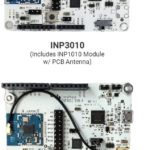 Innophase ICs use a digital polar radio architecture for its Wi-Fi radios. The INP2045 uses this technology, called “PolaRFusion,” to achieve a QAM signal. The company packages the INP2045 into its INP1010 integrated PCB antenna module and INP1011 external antenna module, shown mounted to development boards in the photo. The INP2045 includes and Arm Cortex-M3 processor. System interfaces include I2C, I2S, ADC, GPIO, SDIO, SPI, UART, and JTAG.
Innophase ICs use a digital polar radio architecture for its Wi-Fi radios. The INP2045 uses this technology, called “PolaRFusion,” to achieve a QAM signal. The company packages the INP2045 into its INP1010 integrated PCB antenna module and INP1011 external antenna module, shown mounted to development boards in the photo. The INP2045 includes and Arm Cortex-M3 processor. System interfaces include I2C, I2S, ADC, GPIO, SDIO, SPI, UART, and JTAG.
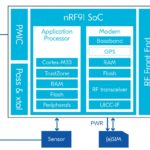 Nordic Semiconductor featured LTE-M and Bluetooth ICs and modules at CES. The nRF9160 cellular IoT System-in-Package lets IoT designers integrate LTE connectivity into their products. The IC includes an Arm Cortex-M33 processor, a modem, RF transceiver, and RF front end. It covers LTE bands from 700 MHz to 2200 MHz. Designed for low-power, low-data-rate applications such as asset tracking, the nRF9160 throughput runs at 300 kbps and 375 kbps.
Nordic Semiconductor featured LTE-M and Bluetooth ICs and modules at CES. The nRF9160 cellular IoT System-in-Package lets IoT designers integrate LTE connectivity into their products. The IC includes an Arm Cortex-M33 processor, a modem, RF transceiver, and RF front end. It covers LTE bands from 700 MHz to 2200 MHz. Designed for low-power, low-data-rate applications such as asset tracking, the nRF9160 throughput runs at 300 kbps and 375 kbps.
 NXP went into CES big time, not just with exhibits but with a spotlight featuring CTO Lars Reger. On 5G, Reger showed how the company’s 5G antennas can be used to cover cities with 5G access. Reger also highlighted the company’s commitment to Wi-Fi, including Wi-Fi 6 (5 GHz) and Wi-Fi 6E (6 GHz). See SoC adds Wi-Fi 4, 5, 6, 6E to IoT devices.
NXP went into CES big time, not just with exhibits but with a spotlight featuring CTO Lars Reger. On 5G, Reger showed how the company’s 5G antennas can be used to cover cities with 5G access. Reger also highlighted the company’s commitment to Wi-Fi, including Wi-Fi 6 (5 GHz) and Wi-Fi 6E (6 GHz). See SoC adds Wi-Fi 4, 5, 6, 6E to IoT devices.
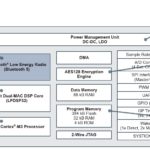 ON Semiconductor highlighted its products for wearables and IoT, which include ICs for Bluetooth, audio, sensors, and power management. One such Bluetooth device is the RSL100 SoC (click on image for diagram), which includes an Arm Cortex-M3 processors, a 32-bit DSP, program memory, PWM, timers, and several interfaces.
ON Semiconductor highlighted its products for wearables and IoT, which include ICs for Bluetooth, audio, sensors, and power management. One such Bluetooth device is the RSL100 SoC (click on image for diagram), which includes an Arm Cortex-M3 processors, a 32-bit DSP, program memory, PWM, timers, and several interfaces.
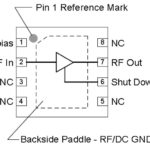 Qorvo introduced its QPL9547 low-noise amplifier (LNA) for cellular base stations at CES. It covers a range of 100 MHz to 6 GHz with a noise figure of 0.3 dB at 2 GHz. The QPL9547 package is just 2 mm&frac2;. The company also introduced Wi-Fi6E front-end modules, QFP4632 and QFP4656. Other new Wi-Fi products include Wi-Fi6 front-end modules.
Qorvo introduced its QPL9547 low-noise amplifier (LNA) for cellular base stations at CES. It covers a range of 100 MHz to 6 GHz with a noise figure of 0.3 dB at 2 GHz. The QPL9547 package is just 2 mm&frac2;. The company also introduced Wi-Fi6E front-end modules, QFP4632 and QFP4656. Other new Wi-Fi products include Wi-Fi6 front-end modules.
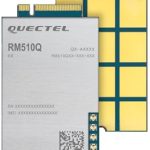 Quectel exhibited 5G modules that let engineers add 5G to CPE and IoT products. The RM510Q uses the M.2 form factor (shown), supporting sub-6 GHz and mmWave frequencies. The RM50xQ supports sub-6 GHz frequencies. The RG50xQ LGA module supports sub-6 GHz as well.
Quectel exhibited 5G modules that let engineers add 5G to CPE and IoT products. The RM510Q uses the M.2 form factor (shown), supporting sub-6 GHz and mmWave frequencies. The RM50xQ supports sub-6 GHz frequencies. The RG50xQ LGA module supports sub-6 GHz as well.
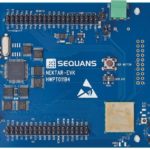 Sequans exhibited its recently introduced Monarch 2 LTE module for IoT devices, which is based on the company’s Monarch 2 chip. The module adds RF front and filters and +23 dBm power amplifiers to the chip, forming a complete LTE interface for low-power IoT applications. It operates on LTE bands covering frequencies from 617 MHz to 2.2 GHz. The company also announced the NEKTAR-B Evaluation Kit (shown), which uses and antenna from Fractus Antennas.
Sequans exhibited its recently introduced Monarch 2 LTE module for IoT devices, which is based on the company’s Monarch 2 chip. The module adds RF front and filters and +23 dBm power amplifiers to the chip, forming a complete LTE interface for low-power IoT applications. It operates on LTE bands covering frequencies from 617 MHz to 2.2 GHz. The company also announced the NEKTAR-B Evaluation Kit (shown), which uses and antenna from Fractus Antennas.
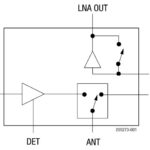 Skyworks added the SKY85780-11 and SKY85784-11 high-power front-end modules to its portfolio, making it one of several companies at CES with Wi-Fi6E products. The modules include an LNA, PA and transmit/receive switch that connects an antenna to the transmit or receive functions. The SKY85784-11 has slightly more transmit and receive signal gain and it includes a coupler pin connected between the detector and antenna switch circuits (not shown in diagram).
Skyworks added the SKY85780-11 and SKY85784-11 high-power front-end modules to its portfolio, making it one of several companies at CES with Wi-Fi6E products. The modules include an LNA, PA and transmit/receive switch that connects an antenna to the transmit or receive functions. The SKY85784-11 has slightly more transmit and receive signal gain and it includes a coupler pin connected between the detector and antenna switch circuits (not shown in diagram).
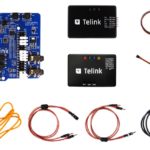 Telink Semiconductor exhibited SoCs that add Bluetooth, ZigBee, Apple HomeKit, and other wireless protocols to IoT devices. Applications include lighting, toys, healthcare, positioning, audio, wearable, and smart home devices.
Telink Semiconductor exhibited SoCs that add Bluetooth, ZigBee, Apple HomeKit, and other wireless protocols to IoT devices. Applications include lighting, toys, healthcare, positioning, audio, wearable, and smart home devices.

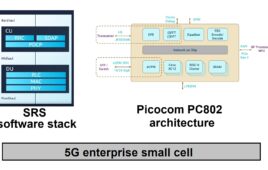


Tell Us What You Think!